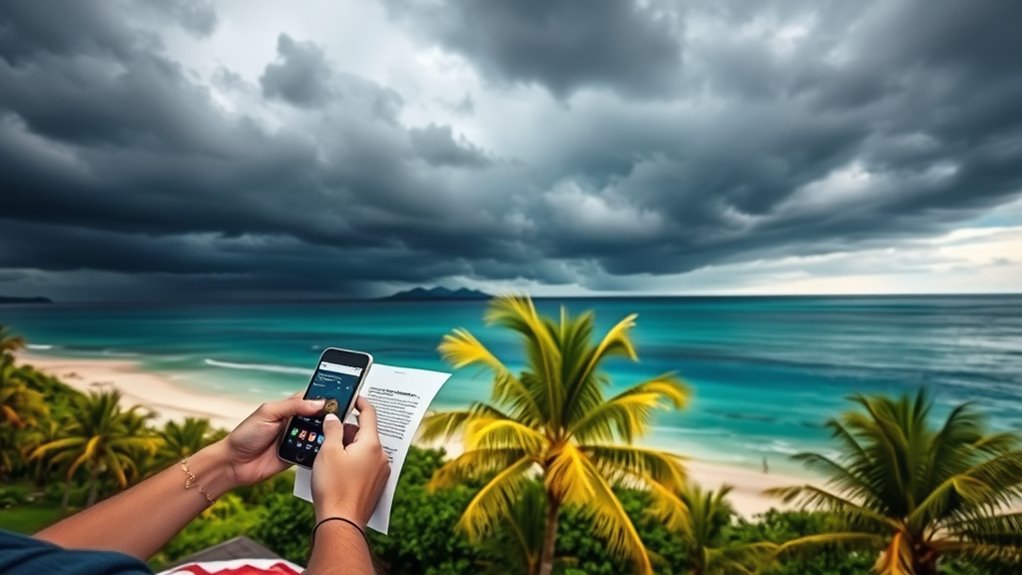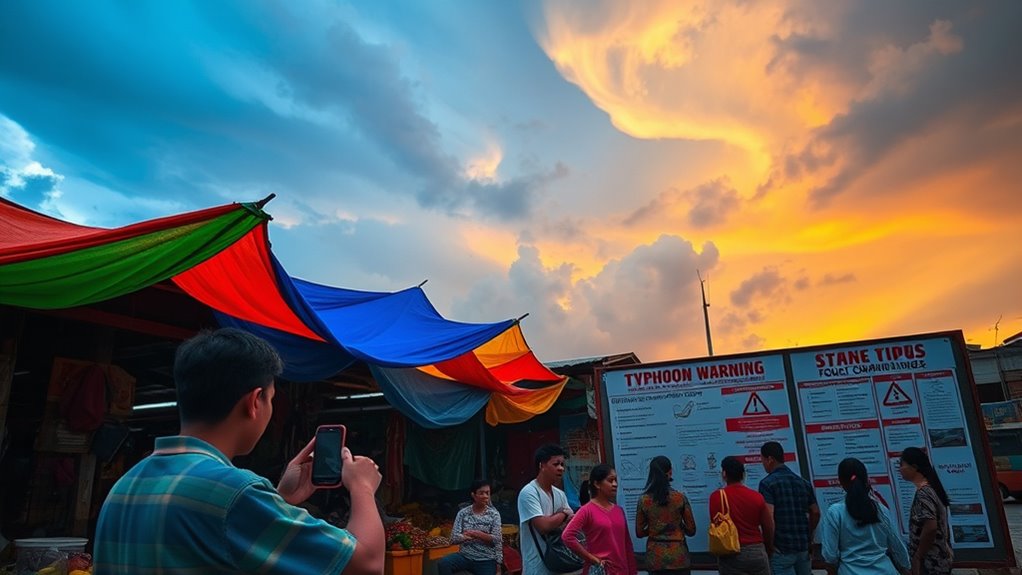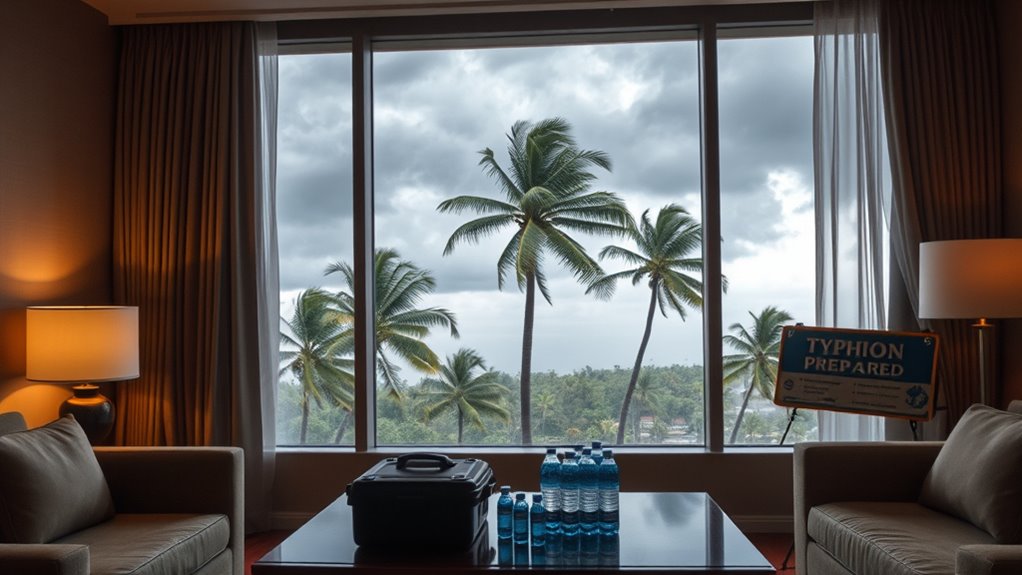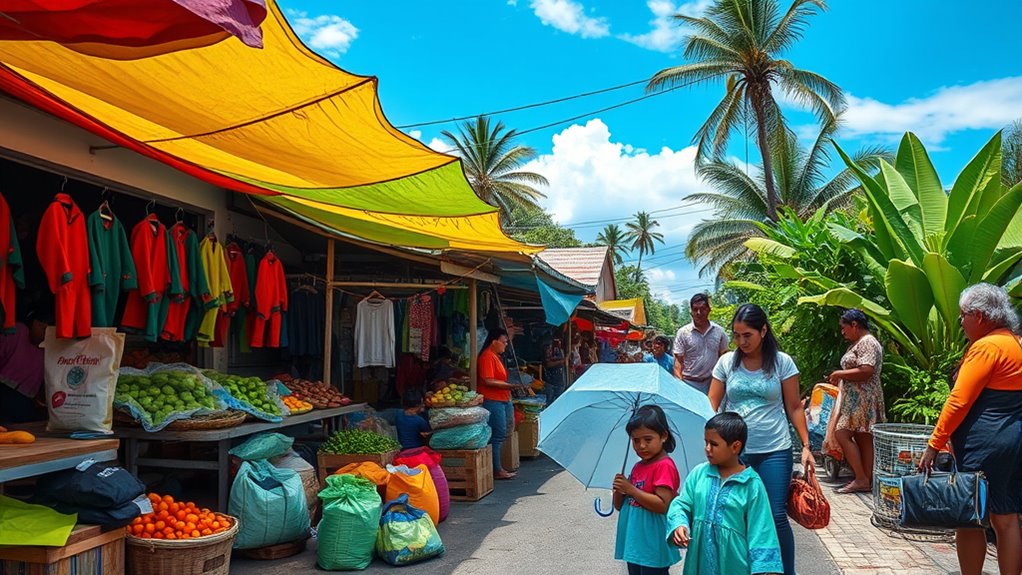To prepare for typhoon season in the Philippines, get extensive travel insurance to cover unexpected events. Stay informed by frequently checking reliable weather updates from sources like PAGASA. Pack emergency supplies like non-perishable food, water, and a first aid kit. Familiarize yourself with your accommodation’s safety measures and establish a family emergency plan, including evacuation routes. Being proactive will help you navigate potential storms effectively. Discover more tips to safeguard your trip during typhoon season.
Key Takeaways
- Purchase comprehensive travel insurance that covers trip interruptions, medical emergencies, and natural disasters like typhoons.
- Stay updated with weather forecasts from reliable sources like PAGASA and NDRRMC several times a day.
- Pack emergency supplies including non-perishable food, bottled water, a first aid kit, and important documents for potential evacuations.
- Create a family emergency plan with designated meeting points and a list of emergency contacts for quick communication.
- Familiarize yourself with local evacuation routes and emergency services in the area you are visiting.
Understanding Typhoon Season in the Philippines

When does typhoon season hit the Philippines, and how does it affect you? It typically peaks from July to October, with August being the most intense month.
You’ll notice that around 20 tropical cyclones enter the area each year, with 8 to 9 making landfall, especially impacting regions like Northern Luzon and Eastern Visayas.
The frequency and strength of these storms have increased due to climate change, leading to significant rainfall—over 30% in northern areas.
As a visitor, you should stay informed about weather updates, have an evacuation plan, and secure any outdoor possessions.
Understanding this season’s risks will help you prepare and stay safe while enjoying your time in the Philippines.
Importance of Travel Insurance

While you might be excited about your trip to the Philippines, it’s important to recognize the significance of travel insurance in safeguarding your journey.
Unexpected medical emergencies can arise, and travel medical insurance covers high healthcare costs, hospital stays, and even emergency evacuations.
Unexpected medical emergencies can occur while traveling, making travel medical insurance essential for covering healthcare costs and emergency services.
Additionally, trip insurance protects your investment by reimbursing non-refundable expenses if your plans change due to unforeseen events like typhoons.
Extensive coverage is vital, especially in a region prone to natural disasters. You’ll want to make sure your policy includes trip interruption, loss of luggage, and coverage for delays.
Monitoring Weather Updates

How can you stay ahead of a typhoon’s path? First, rely on trusted sources like PAGASA and the NDRRMC for timely weather forecasts.
Understanding their color-coded warning systems can help you make quick decisions. Check updates frequently—ideally several times a day—to stay informed about the storm’s trajectory and strength.
Mobile apps such as Weather Philippines can give you easy access to alerts, while following official government accounts on social media provides real-time updates.
Staying connected with local news is also essential for the latest information.
Packing Emergency Supplies

Packing emergency supplies is essential for ensuring your family’s safety during typhoon season. Start with non-perishable food like canned goods and energy bars to last at least three days. Don’t forget to stock bottled water for everyone.
Packing emergency supplies is crucial for your family’s safety during typhoon season; prioritize non-perishable food and sufficient bottled water.
A first aid kit with bandages and antiseptics is vital. Pack flashlights with extra batteries and consider portable power sources for lighting. Include hygiene essentials like soap and toothbrushes.
For clothing, opt for lightweight, quick-drying items and rain gear like umbrellas and raincoats. Protect your electronics and documents in waterproof bags.
Also, gather important documents and any necessary medications. Remember to bring cash, a multi-tool, and a portable radio for updates. These supplies will help you stay safe and comfortable during storms.
Staying Informed About Local Alerts

Staying informed about local alerts is essential during typhoon season, as it empowers you to make timely decisions for your safety.
Start by checking updates from PAGASA, the country’s primary weather source. Use weather apps like Windy or AccuWeather for real-time storm tracking. Familiarize yourself with the TCWS signals, which indicate wind severity and necessary precautions.
Take advantage of early warning systems like PhilAWARE, which enhance disaster readiness. Collaborate with local authorities, as they play a vital role in disseminating alerts.
Keep your devices charged, and set up mobile alerts to receive immediate updates. By staying connected and informed, you can effectively prepare for any typhoon threats during your visit.
Preparing Your Accommodation

Once you’re up to date with local alerts, it’s time to focus on preparing your accommodation for the typhoon season.
Start by securing all doors and windows to prevent damage from strong winds. Clear outdoor areas by moving loose items indoors or securing them tightly. Inspect and clean gutters and drains to avoid flooding. Reinforce your roofing by checking for any necessary repairs.
Store essential emergency supplies, like flashlights and first aid kits, within easy reach. Ascertain your fire extinguishers and smoke detectors are functional. Identify all emergency exits and keep them clear.
Finally, consider investing in a portable power source to maintain critical systems during outages. Home security systems can provide an added layer of protection against potential threats during severe weather events. Being proactive now will help keep you safe later.
Creating a Family Emergency Plan

Creating a family emergency plan is vital for your safety during typhoon season. Start by identifying potential risks in your area, including typhoons and other natural disasters. Stay updated on weather reports and government alerts to make informed decisions.
Create a list of emergency contacts, including family members and local authorities. Designate two meeting points—one close to home and another outside the neighborhood. Choose an out-of-town contact for coordination.
Make sure everyone has reliable communication devices, like mobile phones, and practice drills to refine your plan. Don’t forget to take into account any special health needs within your family and prepare an emergency kit stocked with essential supplies.
Regularly review and update your plan to keep it effective.
Knowing Evacuation Routes

Knowing your evacuation routes is just as important as having a family emergency plan. You need to identify safe zones and evacuation areas before a typhoon hits.
Start by avoiding flood-prone regions and understanding landslide risks, especially in mountainous areas. Familiarize yourself with nearby evacuation centers or safe buildings, and make certain you know the designated routes for evacuation.
Stay updated on evacuation orders from local authorities to guarantee you’re prepared to act quickly. Monitor updates from PAGASA and pay attention to weather warnings.
Being informed about the projected path of the typhoon will help you assess potential dangers. Preparation now can make all the difference when it’s time to evacuate safely.
Post-Typhoon Recovery Actions

As the winds settle and the storm passes, your focus shifts to the essential task of recovery.
Begin by evaluating the damage to identify urgent needs in your community. Clear debris to guarantee safety and restore access to crucial services like electricity and water. Organize relief distribution to provide food, shelter materials, and healthcare for those affected.
Engage local residents in recovery efforts to tailor solutions to their needs. Support initiatives that revive livelihoods, such as providing fishing equipment for fishermen or vocational training programs.
Finally, remember the importance of emotional support services, helping individuals cope with trauma. Collaborate with government and international aid to secure funding and streamline recovery processes, guaranteeing a more resilient community for the future.
Frequently Asked Questions
What Should I Do if My Flight Is Canceled Due to a Typhoon?
If your flight’s canceled due to a typhoon, stay calm and check for immediate notifications from your airline.
Explore refund or rescheduling options, and consider alternative routes if possible.
Airlines often provide support, like complimentary accommodations or meals for affected passengers.
Don’t hesitate to contact local tourism boards for assistance.
Make sure to monitor weather updates and be prepared to adjust your plans accordingly for safety.
Are There Specific Typhoon Safety Apps I Can Download?
When the winds howl and dark clouds gather, you’ll want the right tools at your fingertips. Downloading typhoon safety apps can be a lifesaver.
The NOAH PH app offers real-time updates, while Windy tracks storm movements visually. AccuWeather provides accurate forecasts, and the Hazard app keeps you informed with alerts.
Stay ahead of the storm by customizing your app settings, ensuring you receive timely warnings tailored to your location. Your safety’s worth it!
How Can I Assist Locals During a Typhoon?
You can assist locals during a typhoon by volunteering with relief organizations.
Offer your skills, whether it’s distributing food, helping with medical care, or clearing debris. Engage with community members to understand their needs and help coordinate aid efforts.
It’s also important to share accurate information to keep everyone informed.
Finally, consider donating to local charities that provide essential supplies to those affected, ensuring you make a meaningful impact during their time of need.
What Are the Signs That a Typhoon Is Approaching?
When a typhoon’s approaching, you’ll notice several signs.
First, the barometric pressure drops, and winds pick up speed. Large cirrus clouds gather, and an overcast sky develops with streaks of low clouds.
You might also see ocean swells reaching about 4 meters, with whitecaps forming.
Keep an eye on weather alerts, as PAGASA will raise storm signals to inform you of the storm’s severity and necessary preparations.
Stay alert and informed!
Should I Avoid Certain Regions During Typhoon Season?
Imagine being in a coastal town during a typhoon, with waves crashing and winds howling.
You should definitely consider avoiding regions known for frequent typhoon landfalls, like Cagayan Valley or Bicol, especially during peak months. These areas face the brunt of storms, leading to severe flooding and damage.
Instead, stick to regions with better infrastructure and lower risk, ensuring a safer and more enjoyable experience during your visit.
Conclusion
As you prepare for typhoon season in the Philippines, remember that the country experiences an average of 20 typhoons each year, with around five making landfall. Staying informed and ready can make all the difference in your safety and enjoyment. By monitoring updates, packing essential supplies, and knowing local alerts, you’ll be well-equipped to handle any situation. Embrace the adventure, and don’t let the storms dampen your experience—just be smart and stay prepared!









